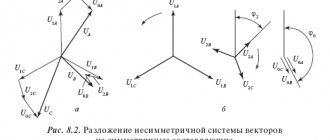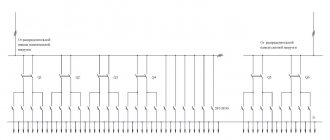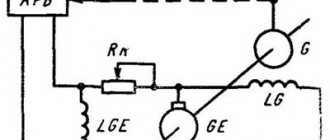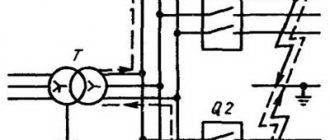What does voltage drop mean?
Drop occurs when load transfer occurs throughout the entire electrical circuit. The action of this load directly depends on the tension parameter in its nodal elements. When the cross-section of the conductor is determined, it is important that its value must be such that during the load it remains within certain limits, which must be maintained for the normal operation of the network.
Mnemonic diagram for Ohm's law
Moreover, the resistance characteristics of the conductors that make up the circuit cannot be neglected. It is, of course, insignificant, but its influence is very significant. The drop occurs when current is transferred. That is why, in order for, for example, a motor or lighting target to operate stably, it is necessary to maintain an optimal level; for this, the electrical circuit wires are carefully calculated.
Important! The limit of the permissible value of the characteristic in question differs from country to country. This cannot be forgotten. If it falls below the values specified in a particular country, wires with a larger cross-section should be used.
Any electrical appliance will work fully if it is supplied with the value for which it is designed. If the wire is taken incorrectly, it will cause large voltage losses and the equipment will operate with reduced parameters. This is especially true for direct current and low voltage. For example, if it is 12 V, then a loss of one or two volts will already be critical.
You may be interested in Features of current sources
Ohm's law for a circuit section
Permissible voltage drop in the cable
The value of electrical voltage loss is regulated and standardized by several rules and instructions for the design of electrical installations. Thus, according to the rule SP 31-110-2003, the total voltage loss from the input point in the room to the electricity consumer furthest from it should not be more than 7.5%. This rule applies to all electrical circuits with a voltage of no more than 400 volts. This rule is used when installing and designing networks, as well as when checking them by Rostechnadzor services.
Important! This document also summarizes the voltage deviation in single-phase household current networks. It should be no more than 5% during normal operation and 10% after an emergency. If the network is low-voltage, that is, up to 50 volts, then +-10% is considered a normal drop.
For power supply cables, rule RD 34.20.185-94 is used. It allows a loss parameter of no more than 6% if the voltage is 10 kV and no more than 4–6% at an electrical voltage of 380 volts. In order to simultaneously comply with these rules and instructions, losses of 1.5% are achieved for low-rise buildings and 2.5% for high-rise buildings.
Voltage drop across resistor
What is the permissible level of voltage loss in the electrical network?
Indoor electrical systems are typically small and low-load, so they are not often tested for voltage loss.
The situation with lighting systems is somewhat different; in them, voltage losses occur much more often, therefore, when carrying out electrical measuring work at sites, the level of losses is necessarily recorded by specialists. To determine the functionality and reliability of internal electrical systems, specialists must be well aware of the permissible level of voltage loss in the network. The parameters of permissible voltage losses must be taken into account at the stages of creating a power supply project for a house, apartment or any other facility.
House power supply project with competent calculations
Back
Forward
Checking the cable for voltage loss
Everyone knows that the flow of electric current through a wire or cable with a certain resistance is always associated with a loss of voltage in this conductor.
According to the rules of the River Register, the total loss of electrical voltage in the main distribution board to all consumers should not exceed the following values:
- for lighting and signaling at a voltage of more than 50 volts - 5%;
- for lighting and signaling at a voltage of 50 volts - 10%;
- for power consumption, heating and heating systems, regardless of electrical voltage – 7%;
- for power consumption with short-term and intermittent operating modes, regardless of electrical voltage – 10%;
- when starting engines – 25%;
- when powering a radio switchboard or other radio equipment or when charging batteries – 5%;
- when supplying electricity to generators and distribution boards - 1%.
You might be interested in how many lumens are in a 100 watt lamp
Based on this, various types of cables capable of supporting such voltage loss are selected.
Example of a calculator for automating calculations
How to use the section selection table?
Table 2 is very easy to use. For example, you need to power a certain device with a current of 10A and a constant voltage of 12V. The line length is 5 m. At the output of the power supply we can set the voltage to 12.5 V, therefore, the maximum drop is 0.5 V.
Available - wire with a cross-section of 1.5 square. What do we see from the table? At 5 meters with a current of 10 A we will lose 0.1167 V x 5m = 0.58 V. It seems to be suitable, considering that most consumers tolerate a deviation of +-10%.
But. After all, we actually have two wires, plus and minus, these two wires form a cable on which the load supply voltage drops. And since the total length is 10 meters, the drop will actually be 0.58 + 0.58 = 1.16 V.
In other words, in this situation, the output of the power supply unit is 12.5 Volts, and the input of the device is 11.34. This example is relevant for powering an LED strip.
And this is without taking into account the contact resistance of the contacts and the imperfection of the wire (“sample” of copper is not the same, impurities, etc.)
Therefore, such a piece of cable most likely will not work; you need a wire with a cross-section of 2.5 square. It will give a drop of 0.7V on a 10m line, which is acceptable.
What if there is no other wire? There are two ways to reduce voltage loss in wires.
1. The 12.5 V power supply should be placed as close to the load as possible. If we take the example above, 5 meters will suit us. This is what they always do to save on wires.
2. Increase the output voltage of the power supply. The risk is that as the load current decreases, the voltage across the load may rise to unacceptable limits.
For example, in the private sector, 250-260 Volts are installed at the output of the transformer (substation); in houses near the substation, the light bulbs burn like candles. I mean, not for long. And residents on the outskirts of the area complain that the voltage is unstable and drops to 150-160 Volts. Loss of 100 Volts! Multiplied by the current, you can calculate the power that heats the street, and who pays for it? We, the “losses” column on the receipt.
How to find the voltage drop and correctly calculate its loss in a cable
One of the main parameters by which tension is calculated is the resistivity of the conductor. Copper or aluminum wires are used for wiring from the station or panel to the room. Their resistivity is 0.0175 Ohm*mm2/m for copper and 0.0280 Ohm*mm2/m for aluminum.
The voltage drop for a 12 volt DC circuit can be calculated using the following formulas:
- determination of the rated current passing through a conductor. I = P/U, where P is power and U is rated voltage;
- determination of resistance R=(2*ρ*L)/s, where ρ is the resistivity of the conductor, s is the cross-section of the wire in square millimeters, and L is the length of the line in millimeters;
- determination of voltage loss ΔU=(2*I*L)/(γ*s), where γ is a value that is equal to the inverse resistivity;
- determination of the required cross-sectional area of the wire: s=(2*I*L)/(γ*ΔU).
Important! Thanks to the last formula, you can calculate the required cross-sectional area of the wire for the load and make a verification calculation of losses.
Table of inductive reactance values
In a three-phase network
To ensure optimal load in a three-phase network, each phase must be loaded evenly. To solve this problem, electric motors should be connected to linear conductors, and lamps should be connected between the neutral line and phases.
The loss of electrical voltage in each wire of a three-phase line, taking into account the inductive resistance of the wires, is calculated using the formula
Calculation formula
The first term of the sum is the active, and the second is the passive component of the tension loss. For ease of calculations, you can use special tables or online calculators. Below is an example of such a table, which takes into account voltage losses in a three-phase overhead line with aluminum wires with an electrical voltage of 0.4 kV.
Example table
Voltage loss is determined by the following formula:
ΔU = ΔUtable * Ma;
Here ΔU is the voltage loss, ΔUtable is the value of the relative losses, % per 1 kW km, Ma is the product of the transmitted power P (kW) and the line length, kW km.
You might be interested in which electric current is more dangerous for humans and why
Single line diagram of a three-phase current line
On the chain section
In order to measure the voltage loss on a section of the circuit, you should:
- Take a measurement at the beginning of the chain.
- Perform voltage measurements at the most remote area.
- Calculate the difference and compare with the standard value. In case of a large drop, it is recommended to check the condition of the wiring and replace the wires with products with a smaller cross-section and resistance.
Important! In networks with voltages up to 220 V, losses can be determined using a conventional voltmeter or multimeter.
A basic way to calculate power loss can be an online calculator, which carries out calculations based on the initial data (length, cross-section, load, voltage and number of phases).
Sample calculator for calculating losses
Thus, you can calculate and calculate voltage losses using simple formulas, which for convenience are already collected in tables and online calculators that allow you to automatically calculate the value based on given parameters.
Voltage regulation in distribution networks 6–20 and 0.4 kV: standards
The standard normalizes the permissible voltage deviations at the ED inputs. There are a number of powerful electric power plants connected directly to 6–20 kV networks (mainly SD), but the bulk of electric power plants receive power from 0.4 kV networks. Therefore, the capabilities of the LV in these networks are of paramount importance. Transformers 35–220/6–20 kV have on-load tap-changers that allow the voltage on 6–20 kV busbars to be regulated according to a given law. At the same time, to compensate for voltage losses in 6–20 kV lines, the highest 313 voltage on the 6–20 kV transformer buses must be maintained in high load modes and the lowest in low load modes.
Distribution transformers 6–20/0.4 kV, in addition to the nominal tap, have four control taps with the number of turns of the primary winding reduced by 2.5 and 5% and increased by the same amounts, which allows changing the transformation ratio Kt. However, to change the control branch it is necessary to disconnect the RT from the network, so such changes can be made only periodically (for example, seasonally), and during the daily change in loads the branches remain constant.
The change in voltage on the 0.4 kV buses of the transformer, which occurs when the branch changes, depends on the operating voltage on the 6–20 kV buses - U1. In table Figure 8.6 shows the transformation ratios and relative voltage additions ∆Et on 0.4 kV buses, corresponding to the indicated branches at different voltages on 6–20 kV buses.
Table 8.6
Regulating characteristics of RT 6–20/0.4 kV
Until 1992 in Russia, the standard voltage of low-voltage networks was considered to be 220/380 V, therefore the calculated values of voltage additions ∆Et in relation to this voltage were 5% higher and ranged from 0 to +10%. Currently, in accordance with international standards, the voltage is set to 230/400 V (Appendix 8).
Since the values of ∆Et change slightly over a wide range of changes in U1, in practical calculations their calculated values are often used - rounded values corresponding to the change in the number of turns of the primary winding of the transformer. To carry out more accurate calculations of voltage deviations on 0.4 kV buses with a known value of U1, it is necessary to use transformation ratios directly.
We will consider methods for calculating the RN law on 6–20 kV buses of the central power plant and selecting 6–20/0.4 kV PT control branches using the example of a conventional diagram of a 6–20 kV line shown in Fig. 8.19, a. At maximum load, the line voltage decreases as it moves away from the CPU. Its reduction on 0.4 kV RT buses is shown by the dashed line in Fig. 8.19, b. RTs have five control branches that allow you to change the voltage in steps of 2.5%.
In 0.4 kV lines, it is necessary to maintain a voltage that provides permissible deviations of ± 5% for all electrical devices connected to the line. In this case, at the nearest ED (A1) it is necessary to maintain the voltage deviation as close as possible to +5%, so that at the remote ED (B1) it does not go beyond the lower permissible limit of –5%. Therefore, on the CPU buses in maximum load mode, it is necessary to maintain a voltage deviation above +5% by the amount of voltage loss from the CPU buses to the nearest ED network 0.4 kV, %:
On this RT and others located in the zone of voltage losses from ∆U s.b to (∆U s.b + 2.5)%, install the first working branch with ∆Et = –5%, in the zone of voltage losses from ( ∆U s.b + 2.5)% to (∆U s.b + 5)% – the second working branch, etc. As a result, the voltage diagram on the 0.4 kV RT buses looks like a sawtooth line 1 in Fig. 8.19, b.
The voltage at the nearest ES connected to the RT, located at the beginning of each zone, is maintained close to +5%. The permissible voltage loss in 0.4 kV lines can reach 10%, and at the same time, the voltage deviation at remote electric devices will not exceed –5%. At the end of the zone, the voltage deviation at the nearest ED can no longer exceed +2.5%, therefore, in these 0.4 kV lines, the permissible voltage loss should not exceed 7.5%. Since during operation the voltage losses in the maximum load mode of the network change, it is necessary to periodically change the RT branches. In this case, a specific RT can end up in various places in its own and adjacent zones. In this regard, the permissible voltage losses in 0.4 kV lines during their design should not
Rice. 8.19. Simplified 10 kV line diagram and voltage diagrams
exceed 7.5%. The voltage diagram for remote EPs (B1 – BN + 1) is reflected by a sawtooth line 2.
In the minimum daily load mode, voltage losses in all network elements are reduced, and the operating branches of the RT remain the same. At a constant voltage in the CPU, the voltage deviation on the 0.4 kV RT buses will increase with distance from the CPU. In order to bring the voltage at the EP AN (the closest EP in the 0.4 kV RT network connected at point D, located at the beginning of the last branch zone) to +5%, it is necessary to reduce the voltage in the CPU to δU CPU (Fig. 8.19, c). The range dр.н = δU CPU – δU CPU is called the range of pH in the CPU; regulation, in which the highest voltage is maintained in the maximum daily load mode, and the lowest - in the minimum load mode, is called counter LV.
RT loads can have different graph shapes. Along with the utility load with a pronounced evening maximum, enterprises whose maximum load occurs during the daytime are powered from the network. Voltage losses in 0.4 kV RT lines, the load of which is not maximum in the maximum network load mode, are reduced. The voltage at remote EDs of such RTs is reflected in diagram 3 in Fig. 8.19, b; in this case, there is a margin relative to the level of –5%. In the mode of low total network load, when the voltage in the CPU has to be reduced according to the conditions of the bulk of consumers, the loads of such RTs increase, and the voltage diagram for remote EDs of these RTs looks like 3 in Fig. 8.19, c. In this case, the voltage deviation for a number of EDs goes beyond the limit of –5%. The best position is found for the RTs connected to point D, the voltages at the inputs of which are maintained constant in all modes.
Counter RN is carried out according to the CPU load schedule, which is formed by all consumers. Therefore, with heterogeneous RT load schedules, the regulation law does not correspond to any consumer to a greater or lesser extent. The degree of discrepancy for a particular consumer will be greater, the smaller the share of consumers with a similar schedule in the total load and the more different their schedule is from the schedule of the bulk of consumers.
From the point of view of distribution of heterogeneous loads, 6–20 kV networks can be divided into three groups:
- networks with relatively homogeneous RT loads;
- networks with heterogeneous loads of lines extending from the CPU (interline heterogeneity), while within each line the loads are homogeneous;
- networks with heterogeneous loads connected to a common 6–20 kV line (intraline heterogeneity).
In networks with homogeneous RT loads, permissible voltage deviations for all electric power supply units connected to 0.4 kV networks can be ensured using the LV in the CPU and the appropriate selection of operating RT branches. The only condition is not to exceed the permissible voltage losses in networks of 6–20 kV (medium voltage networks) and 0.4 kV (low voltage networks). In a medium voltage network they should not exceed 12.5% (10% is the maximum possibility of compensating for losses using RT branches plus 2.5% is the permissible losses in the last zone beyond point D, Fig. 8.19), and in low voltage networks - 7.5%.
In networks with significant interline heterogeneity, it is impossible to ensure acceptable voltage conditions on the 380 V buses of all RTs using the LV in the CPU. The only way here is to allocate the most heterogeneous line to a separate control device (voltage booster transformer). If there are two transformers with on-load tap-changers in the CPU and, according to the reliability of the power supply, their separate operation on the 6–20 kV side is permissible, it is advisable to divide the lines into two groups with relatively homogeneous loads and connect them to different buses.
To improve the voltage regime for heterogeneous consumers in lines with intraline heterogeneity, it is necessary to use local regulation means, which are capacitor units. Connecting such installations reduces voltage losses and accordingly increases its level with the same operating RT branch. The degree of increase depends on the reactance of the network in relation to the connection point. The regulating effects of 100 kvar capacitors on 6–20/0.4 kV transformers and 0.4 kV lines are given in Table. 8.7.
Table 8.7
Regulating effects of capacitor units for various network elements
Regulatory effects on sections of 6–20 kV networks are practically insignificant. It is advisable to install capacitor units deep in a 0.4 kV network, especially in the case of a 0.4 kV overhead line. Here, a small installation power may be sufficient (in foreign countries, outdoor capacitors are used on overhead line supports). Such devices can be installed in lines with heterogeneous loads connected to the RT and located close to the CPU, or lines with uniform loads connected to the RT and located in the last branch area.
The voltage in lines with heterogeneous loads connected to the RT and located close to the CPU increases. In the first case, this occurs due to a reduction in voltage losses in the 0.4 kV lines themselves (Table 8.7) - in this case, line 3 in Fig. 1 rises. 8.19, c, - and in the second case, you can refuse to install the next branch on the RT in the last zone (dashed line in Fig. 8.19, d), ensuring an increase in the voltage in the CPU in low-load network mode.
The discreteness of the transformer control stages in the CPU has a significant impact on the voltage conditions in the network. Transformers with OLTC 35 and 220 kV have a regulation level ∆Et = 1.5%, and 110 kV – 1.78%. Therefore, when the on-load tap-changer is triggered, the voltage at all points of the network changes abruptly by the value of the step. Typically, a few on-load tap-changer operations per day are sufficient.
At serviced substations, switching can be carried out by personnel on duty, at unattended substations - by remote actuators or automatic control devices. To prevent backfires, the control dead zone ε installed in the device must be larger than the control stage. The greater the difference ε – ∆Et, the less often the control device operates, but the rougher the regulation turns out to be. To ensure a compromise between the on-load tap-changer operation frequency and the control accuracy, the dead zone should be taken to be 0.5–0.7% larger than the control stage.
Some experts believe that in order to ensure standardized voltage deviations, it is necessary to design networks for permissible voltage losses, reduced relative to the above values of 12.5% and 7.5% by the value of the regulation dead zone, that is, by at least 2%. Considering the probabilistic nature of the voltage change and the admissibility of its presence for 1 hour 12 minutes per day in a zone of up to ±10%, this condition seems too stringent. At the same time, reducing the permissible voltage losses to 11.5% and 6.5% seems economically justified. The required LV range in the CPU depends on the maximum voltage losses in the 6–20 kV network, which determine the number of PT control branches used (No), and on the range of load changes during the day, characterized by the coefficient kmin. The pH range can be determined by the formula
The required LV ranges in the CPU at various values of voltage losses in the network of 6–20 kV and the coefficient kmin are given in Table. 8.8.
Table 8.8
CPU voltage regulation ranges
Currently used automatic voltage regulation devices in the CPU implement a linear RN law in the CPU depending on the current load of the CPU. However, the linear law is not the best, especially with non-uniform RT loads. The optimal law can be obtained by calculating for each hour of the day the required voltage deviations in the CPU at the RT loads corresponding to each hour and the total network load. One of the PH laws obtained in this way is shown in Fig. 8.20. Calculations show that the greater the heterogeneity of the RT loads and the closer the RTs with heterogeneous loads are located to the CPU, the more the required voltage regulation law in the CPU differs from linear. With the current level of development of digital technology, creating a regulator that implements such regulatory laws does not seem to be too difficult a task.
Rice. 8.20. Nonlinear law of voltage regulation in the power center
Below (in example 8.3) a detailed calculation was carried out for the choice of the RN law on the 10 kV buses of the 10 kV feeder CPU and the 10/0.4 kV RT working branches. If a 35/10 kV transformer without an on-load tap-changer is installed in the 10 kV feeder CPU, the OL on its 10 kV busbars is assigned to a 110/35 kV transformer with an on-load tap-changer. The methodology for calculating the LV law on the 35 kV buses of a 110/35 kV transformer and selecting the optimal working branches of 35/10 kV transformers without on-load tap changers was described earlier in paragraph 6.2.5.
Example 8.3. In Fig. Figure 8.21 shows a 10 kV feeder, above the sections of which the voltage losses at the highest loads are indicated, %. The lowest feeder load is 30% of the highest (kmin = 0.3). Voltage losses in each 10/0.4 kV RT in the heaviest load mode are assumed to be 1.7%. The maximum voltage loss in 0.4 kV lines is 7%. Permissible voltage deviations δU+ = +5% and δU– = –5%. It is required to calculate the RN law on 10 kV CPU buses.
Solution. The voltage losses from the 10 kV buses of the CPU to the 0.4 kV buses of each RT in the heaviest load mode are:
The maximum voltage level on the CPU buses is determined by the conditions of RT 1. In order for the voltage deviation on the 0.4 kV buses of this RT to be +5%, on the CPU buses it must be equal to δU CPU = δU+ + ∆U 1 – ∆Et1 = 5 + 2.5 – (–5) = 12.5%.
Such excess voltage on the CPU buses is unacceptable due to the operating conditions of the insulation. It is necessary to reduce it to at least 10%. To do this, on RT 1 you will have to install not the first branch with ∆Et1 = –5%, but the second one with ∆Et2 = –2.5%. If a second branch is also installed on RT 2–5, then the voltage deviations on the 0.4 kV buses RT 1–5 will be:
Considering that the LV stage at RT 10/0.4 kV is 2.5%, it is possible to raise the voltage to the level of +5% by installing the next working branch only at RT 4 and 5 (at other RTs with such an installation it will be higher + 5 %). When installing a third branch with ∆Et3 = 0% on these RTs, we obtain δU 4 = 10 – 6.0 – 0 = 4.0% and δU 5 = 10 – 6.9 – 0 = 3.1%.
If in the 0.4 kV lines RT 3 and 5 there is a small voltage loss from the RT buses to the nearest ED (about 0.6%), then on RT 3 a third branch can be installed with ∆Et3 = 0%, and on RT 5 - a fourth with ∆Et4 = +2.5%. Then on the 0.4 kV buses of both RTs there will be +5.6%, and at the nearest EDs +5%. In this case, the numbers of working branches are 35–220 kV 6–10 kV 0.4 kV 0.4 kV 1 bb 1 bu Rep. 1 Rep. N Network 380/220 Network 380/220 1 ub 1 uy ∆Uл ∆Ut ∆Ut ∆Uн ∆Uн 4 3 0.8% 2b 0.6% 1.3% 1.6% 0.9% 2у 1 2 3 4 5 322 at RT 1–5 will be 2, 2, 3, 3, 4 with ∆Et = –2.5; –2.5; 0; 0; +2.5%; voltage deviations on the 0.4 kV RT buses will be:
and for remote ES there is 7% less:
The lowest voltage (–3%) is observed at a remote point in the 0.4 kV RT 4 network. It will not go beyond the –5% limit if the voltage in the CPU is reduced by 2% and amounts to 10 – 2 = 8%. This value is the lower limit of the pH range in the heaviest load mode. Voltage deviations for all 0.4 kV EP networks will not go beyond the permissible limits in the heaviest load mode if the voltage deviation on the CPU buses in this mode is maintained in the range from +8 to +10%.
In low-load network modes, voltage losses will be reduced to 30% of losses in high-load modes. Voltage deviations on the RT buses, taking into account the control branches, will be:
The highest voltage is observed on the RT 5 buses, which is critical for the voltage in the CPU in light load mode. The voltage on the CPU buses must be reduced by 5.43% and maintained at the level δU CPU = 10 – 5.43 = 4.57%.
Voltage deviations on the RT buses in the low-load network mode will be:
and for remote ES:
The lowest voltage (–0.96%) is observed at a remote point in the 0.4 kV RT 2 network. It will not go beyond the limit of –5% if the voltage in the CPU is reduced by 4.04% and amounts to Vm1 = 4.57 – 4.04 = 0.53%. This value is the lower limit of the pH range in light load mode.
As a result, the requirements for RN in the CPU are formulated as follows: the voltage deviation on the CPU buses in the mode of heavy network loads must be maintained in the range from +8 to +10%, and in the mode of light network loads - in the range from +0.53 to + 4.57%, in intermediate modes - in accordance with the linear dependence on the load. In this case, the law of voltage regulation in the CPU is represented by more than one line, as in Fig. 6.2 and 8.20, but in the form of a zone of voltage deviations (Fig. 8.22).
It should be noted that the above calculations, accurate to the second decimal place, do not at all correspond to the accuracy of the original data. Therefore, in practical problems they can be rounded to 0.5%.
Rice. 8.22. Law of voltage regulation in the power center of a 10 kV network










